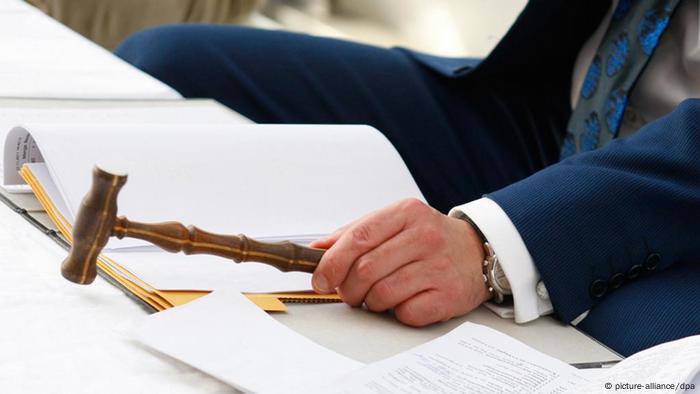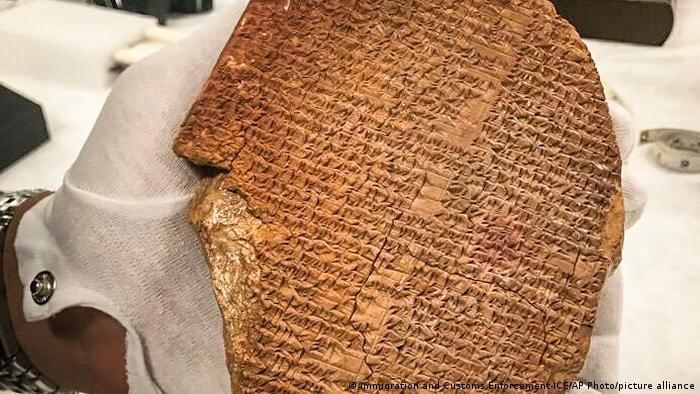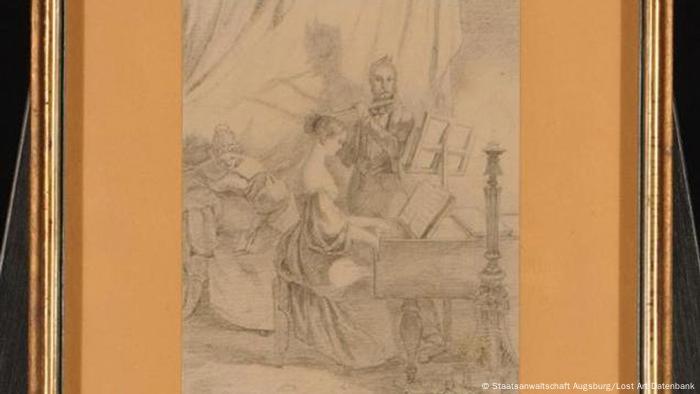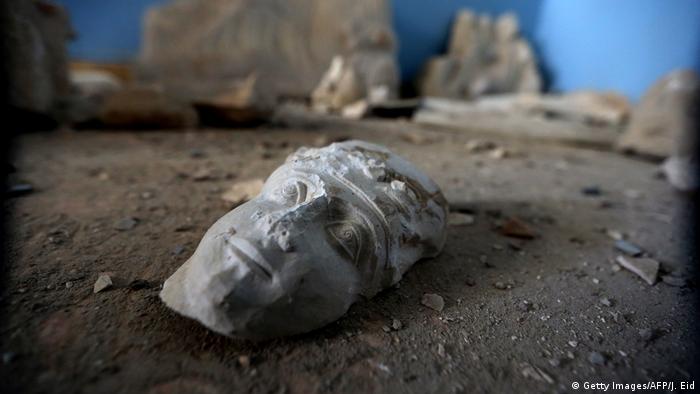CRIMINAL CAPITALI$M; GRAVE ROBBERY
Looted art: Mexico, Panama protest Munich house auction
Pre-Columbian artifacts are up for sale at an auction house in Munich, although Mexico claims to be the rightful owner of 74 pieces. Is this a case of stolen goods?

Numerous Latin American countries have called to stop an auction of pre-Hispanic artifacts in Munich, saying there is no legal basis for their sale.
The controversial auction was set to take place as planned on Tuesday. The 324 artifacts on offer in Munich, most of which are vessels, coins and jewellery, date roughly from 1500 B.C. to 1460 A.D. The stone face mask of an Olmec dignitary is the most valuable object in the auction, with an estimated price of €100,000 ($117,000).
Ambassadors from the Group of Latin America and the Caribbean (GRULAC) asked the auction house to suspend the sale at a press conference on Tuesday morning. They also called on German authorities and the German public to step in.
The auction of objects from seven countries violates the national laws of the respective countries, international law and "possibly German law," they explained during the conference, adding that it is "worrying that the moral right of our Indigenous people is being violated in this way."
Mexico claims auction items
The controversy began with a complaint filed with the Mexican Attorney General's Office and a letter from Mexico's culture minister, Alejandra Frausto.
Frausto informed the auction house in a letter that 74 items in the auction catalog had been identified as belonging to Mexico.
The auction house responded with a statement saying that all the artifacts on offer had "proof of provenance that the objects are in Germany legally." All objects had been investigated by the Art Loss Register, they said.

Mexico's Culture Minister Alejandra Frausto has called for the auction to be stopped
The Art Loss Register is a private database for lost and stolen artworks, founded in 1991 by the International Foundation for Art Research, art trade associations and auction houses. Dealers can use the database to research the provenance of artworks before a planned auction, for example.
If the respective object is not found in the database, the register confirms with a certificate that it was not reported as stolen or lost at the time of the search. However, this does not completely rule out the possibility that theft or loss occurred and was not included, as the register is not linked with other databases.
Panama calls for objects to be removed
Panama has also called for the auction house to withdraw from sale seven pre-Columbian artifacts, namely Cocle Parita and Cocle Conte-style pottery vessels.
In a statement on Monday, the Panamanian Foreign Ministry said it had informed its German counterpart about "the disagreement with the sale of these objects, as they could be part of Panamanian historical heritage," according to a statement reported by the AFP news agency. The Central American country's embassy said it wanted experts from the Panamanian Culture Ministry to determine their origin and the legal situation surrounding them.
According to the auction house's website, the seven Cocle Parita- and Cocle Conte-style pottery vessels are among more than 300 pre-Hispanic objects from Mexico, Guatemala, Costa Rica, Panama, Bolivia and Peru set for auction on Tuesday.
Mexico's ambassador to Germany, Francisco Quiroga, warned potential buyers in a Twitter note on Monday: "To the potential buyers we say: This trade is tainted with illegality and insensitivity."
Referring to items dating back more than 500 years but valued at only a few hundred euros, he said: "If something sounds too good to be true, don't be surprised if it turns out to be false." The auction house was not available for comment.
It is unclear what concrete demands Mexico's Culture Ministry has made beyond the cancellation of the auction. In Mexico's view, the sale of the artifacts is a criminal offense under Mexican law, and such sales contribute to smuggling and cross-border organized crime.
Clothing brands also targeted
Mexico's Culture Ministry has already been making headlines with similar claims that reach beyond the art world. Back in June, it accused three international clothing companies, including the Spanish fashion chain Zara, of cultural appropriation. The ministry claimed companies had used patterns of Indigenous population groups in their collections without any benefit to the communities.

Mexico's Culture Ministry took a swipe at Zara for using a pattern based on an Indigenous design
The patterns are said to be based on traditional patterns of the Mixteca community in the southwestern state of Oaxaca. Culture Minister Frausto had announced last year that Mexico would no longer tolerate cultural appropriation without compensation. The ministry aims to protect the country's cultural heritage.
Mexico has previously objected to auctions of pre-Columbian art objects in France and the United States, as well as other countries. Latin America historian Stefan Rinke, speaking with German broadcaster Deutschlandfunk Kultur, said such protests have been seen as symbolic and are used by the government of President Andres Manuel Lopez Obrador to secure the votes of Mexico's Indigenous population.
Pre-Columbian artifacts are up for sale at an auction house in Munich, although Mexico claims to be the rightful owner of 74 pieces. Is this a case of stolen goods?

Numerous Latin American countries have called to stop an auction of pre-Hispanic artifacts in Munich, saying there is no legal basis for their sale.
The controversial auction was set to take place as planned on Tuesday. The 324 artifacts on offer in Munich, most of which are vessels, coins and jewellery, date roughly from 1500 B.C. to 1460 A.D. The stone face mask of an Olmec dignitary is the most valuable object in the auction, with an estimated price of €100,000 ($117,000).
Ambassadors from the Group of Latin America and the Caribbean (GRULAC) asked the auction house to suspend the sale at a press conference on Tuesday morning. They also called on German authorities and the German public to step in.
The auction of objects from seven countries violates the national laws of the respective countries, international law and "possibly German law," they explained during the conference, adding that it is "worrying that the moral right of our Indigenous people is being violated in this way."
Mexico claims auction items
The controversy began with a complaint filed with the Mexican Attorney General's Office and a letter from Mexico's culture minister, Alejandra Frausto.
Frausto informed the auction house in a letter that 74 items in the auction catalog had been identified as belonging to Mexico.
The auction house responded with a statement saying that all the artifacts on offer had "proof of provenance that the objects are in Germany legally." All objects had been investigated by the Art Loss Register, they said.

Mexico's Culture Minister Alejandra Frausto has called for the auction to be stopped
The Art Loss Register is a private database for lost and stolen artworks, founded in 1991 by the International Foundation for Art Research, art trade associations and auction houses. Dealers can use the database to research the provenance of artworks before a planned auction, for example.
If the respective object is not found in the database, the register confirms with a certificate that it was not reported as stolen or lost at the time of the search. However, this does not completely rule out the possibility that theft or loss occurred and was not included, as the register is not linked with other databases.
Panama calls for objects to be removed
Panama has also called for the auction house to withdraw from sale seven pre-Columbian artifacts, namely Cocle Parita and Cocle Conte-style pottery vessels.
In a statement on Monday, the Panamanian Foreign Ministry said it had informed its German counterpart about "the disagreement with the sale of these objects, as they could be part of Panamanian historical heritage," according to a statement reported by the AFP news agency. The Central American country's embassy said it wanted experts from the Panamanian Culture Ministry to determine their origin and the legal situation surrounding them.
According to the auction house's website, the seven Cocle Parita- and Cocle Conte-style pottery vessels are among more than 300 pre-Hispanic objects from Mexico, Guatemala, Costa Rica, Panama, Bolivia and Peru set for auction on Tuesday.
Mexico's ambassador to Germany, Francisco Quiroga, warned potential buyers in a Twitter note on Monday: "To the potential buyers we say: This trade is tainted with illegality and insensitivity."
Referring to items dating back more than 500 years but valued at only a few hundred euros, he said: "If something sounds too good to be true, don't be surprised if it turns out to be false." The auction house was not available for comment.
It is unclear what concrete demands Mexico's Culture Ministry has made beyond the cancellation of the auction. In Mexico's view, the sale of the artifacts is a criminal offense under Mexican law, and such sales contribute to smuggling and cross-border organized crime.
Clothing brands also targeted
Mexico's Culture Ministry has already been making headlines with similar claims that reach beyond the art world. Back in June, it accused three international clothing companies, including the Spanish fashion chain Zara, of cultural appropriation. The ministry claimed companies had used patterns of Indigenous population groups in their collections without any benefit to the communities.

Mexico's Culture Ministry took a swipe at Zara for using a pattern based on an Indigenous design
The patterns are said to be based on traditional patterns of the Mixteca community in the southwestern state of Oaxaca. Culture Minister Frausto had announced last year that Mexico would no longer tolerate cultural appropriation without compensation. The ministry aims to protect the country's cultural heritage.
Mexico has previously objected to auctions of pre-Columbian art objects in France and the United States, as well as other countries. Latin America historian Stefan Rinke, speaking with German broadcaster Deutschlandfunk Kultur, said such protests have been seen as symbolic and are used by the government of President Andres Manuel Lopez Obrador to secure the votes of Mexico's Indigenous population.
Germany's controversial past
Germany has been at the center of several controversies surrounding art restitution, which have continued to the present day. There have been numerous debates, for example, around the ethnological collections of Berlin's newest museum, the Humboldt Forum. Many of the items were acquired during the colonial period, including the Benin Bronzes, masterpieces taken during a savage plundering of the Kingdom of Benin by British troops in 1897.
Germany is also dealing with the topic of art restitution in the context of World War II, when the Nazis systematically plundered Jewish art collections in Germany. There have been many cases in which art dealers profited from the persecution of Jewish collectors, and it's not uncommon for auction houses to be involved.
This article was translated from German with additional information from AFP
GURLITT COLLECTION: GERMANY'S MOST INFAMOUS NAZI-LOOTED ART TROVECarl Spitzweg, Playing the Piano, ca. 1840This drawing by Carl Spitzweg was seized in 1939 from Jewish music publisher Heinri Hinrichsen, who was killed at the Auschwitz death camp in 1942. It was acquired by Nazi art dealer Hildebrand Gurlitt — and later found among the spectacular collection of works hoarded by his son, Cornelius Gurlitt. The work has now been handed over to Christie's auction house at the request of Hinrichsen's heirs.
UN and US officials will return a stone inscription bearing part of the Epic of Gilgamesh to their counterparts from Iraq at a ceremony in Washington this week.

The 'dream tablet' is imprinted with cuneiform script
UNESCO officials will return a stone inscription bearing part of the Epic of Gilgamesh, one of the oldest known works of literature in the world, to Iraq, the UN agency has said in a statement.
They will hand the tablet to their counterparts from Iraq at a ceremony in Washington on Thursday, September 23, at the Smithsonian Institution, the statement said.
Some 17,000 other artifacts that were also looted following the US invasion of Iraq in 2003 will be returned to Baghdad at the event.
"By returning these illegally acquired objects, the authorities here in the United States and Iraq are allowing the Iraqi people to reconnect with a page in their history," UNESCO Director-General Audrey Azoulay said, adding that this restitution was a "major victory over those who mutilate heritage and then traffic it to finance violence and terrorism."
'Unprecedented' restitution
In July, the US Department of Justice announced it would be returning the artifacts to Iraq.
Calling the restitution "unprecedented," Iraqi Culture Minister Hassan Nazim said in a press statement at the time that it was "the largest return of antiquities to Iraq" and a "result of months of efforts by the Iraqi authorities in conjunction with their embassy in Washington."
In 2018, the British government returned ancient objects that were similarly looted after the US invasion and then appeared in England.
Speaking to DW, Iraqi historian Abdullah Khorsheed Qader, who is an archaeologist and professor at the Salah-al-Din University in Erbil, northern Iraq, and director of the Iraqi Institute for the Conservation of Antiquities and Heritage, said he was elated the objects were being brought back to his country. "Feeling great and hopeful because of the positive responses from the United States of America," he told DW in an email in July.
Stolen during the US invasion
"Most of these artifacts were part of the materials that were looted from the Iraq Museum in Baghdad during the US invasion," Elizabeth Stone, an archaeologist and professor of anthropology at the Stony Brook University in New York, told DW.
Stone has been a part of various archaeological expeditions to Iraq, including a notable one in 2012, where she and her team excavated close to the site of Ur, the home of the biblical figure of Abraham.
According to Stone, these objects left Iraq as part of an illegal trade in antiquities. "It was clear to everyone that these had been stolen from the Museum since they had catalog numbers on them and so could not have come from illegal excavations."
Some objects were confiscated by customs officials, but others were bought by Cornell University and Hobby Lobby, the arts and crafts chain, Stone said.
Hobby Lobby's involvement
Hobby Lobby was in the news recently after it was revealed the business had acquired a rare tablet in cuneiform script, inscribed with a portion of the Epic of Gilgamesh. The object was bought to display at the Museum of the Bible in Washington DC — the institution is funded by the family of David Green, Hobby Lobby's founder.
On July 27, a New York court ordered the forfeiture of the object, which was reportedly purchased from the family of a London coin dealer by an American antiquities dealer, the US Department of Justice said in a statement.
"The antiquities dealer and a US cuneiform expert shipped the tablet into the United States by international post without declaring the contents as required. After the tablet was imported and cleaned, experts in cuneiform recognized it as bearing a portion of the Gilgamesh Epic. The tablet measures approximately 6 inches by 5 inches [15 x 12 centimeters] and is written in the Akkadian language," according to the press statement.
The Epic of Gilgamesh
The Sumerian poem is considered one of the oldest works of literature, and together with several thousand other objects, comprises one of the largest caches of archaeologically important artifacts stolen from Iraq during its turbulent years in the past few decades.
According to UNESCO, the Gilgamesh tablet was stolen in the 1990s, following the Gulf War, emerging fraudulently in the US market in 2007.
Illegal excavation, theft and smuggling of historical artifacts is an ongoing problem — especially in Iraq and Syria — with black market dealers, smugglers and members of the "Islamic State" (IS) exploiting the chaotic situation in the region, where it is relatively easy to find antiquities and sell them abroad.
This article was updated from a previous version published on July 30, 2021.
Hobby Lobby was in the news recently after it was revealed the business had acquired a rare tablet in cuneiform script, inscribed with a portion of the Epic of Gilgamesh. The object was bought to display at the Museum of the Bible in Washington DC — the institution is funded by the family of David Green, Hobby Lobby's founder.
On July 27, a New York court ordered the forfeiture of the object, which was reportedly purchased from the family of a London coin dealer by an American antiquities dealer, the US Department of Justice said in a statement.
"The antiquities dealer and a US cuneiform expert shipped the tablet into the United States by international post without declaring the contents as required. After the tablet was imported and cleaned, experts in cuneiform recognized it as bearing a portion of the Gilgamesh Epic. The tablet measures approximately 6 inches by 5 inches [15 x 12 centimeters] and is written in the Akkadian language," according to the press statement.
The Epic of Gilgamesh
The Sumerian poem is considered one of the oldest works of literature, and together with several thousand other objects, comprises one of the largest caches of archaeologically important artifacts stolen from Iraq during its turbulent years in the past few decades.
According to UNESCO, the Gilgamesh tablet was stolen in the 1990s, following the Gulf War, emerging fraudulently in the US market in 2007.
Illegal excavation, theft and smuggling of historical artifacts is an ongoing problem — especially in Iraq and Syria — with black market dealers, smugglers and members of the "Islamic State" (IS) exploiting the chaotic situation in the region, where it is relatively easy to find antiquities and sell them abroad.
WHAT'S LEFT OF THE ANCIENT CITY OF PALMYRA?IS strikes againWhat is now left of the ancient ruins at Palmyra - known as the "Pearl of the Desert" - is uncertain after a new strike by IS militants on Thursday. This photo shows the face of statue at a destroyed museum in March 2016. Syrian government forces had recaptured Palmyra that month from jihadists, who view the UNESCO-listed site's ancient ruins as idolatrous. 12345
Iraqi officials prepare
Meanwhile, archaeologists like Qader are happy that efforts to bring back the treasures have borne fruit. "Iraqi contacts with the American side made it clear that the smuggled antiquities are in the safe hands of the American Homeland Security," Qader says. Embassy officials had been communicating for many years to recover these pieces and "this has become a reality, finally," adds Qader.
He hopes that the rest of the world, too, will step in and help recover other lost artifacts. Meanwhile, the archaeologist and his colleagues are busy laying the groundwork for re-establishing archaeological institutions that were damaged during years of war and conflict.
Together with US organizations like the Smithsonian Institution and the University of Delaware, Qader is training young professionals and educating the community.
One important goal of his program is "restoring confidence and self-belief in the Iraqi Museum community and archaeological professionals by building and strengthening a national conservation program for cultural heritage."EXCITING ARCHAEOLOGICAL DISCOVERIES OF 2021Hellenistic-era warship in sunken cityA Greek warship found in the sunken city of Heraklion in the Abi Qir Bay in Egypt, is the latest discovery of very rare Hellenistic-era ships. Heraklion - also known as Thonis - was hit by earthquakes, tsunamis, rising sea levels, and soil liquefaction at end of the 2nd century BC. The ship was docking near the temple of Amun, when the entire city collapsed, burying it under the debris.
This article was updated from a previous version published on July 30, 2021.



No comments:
Post a Comment